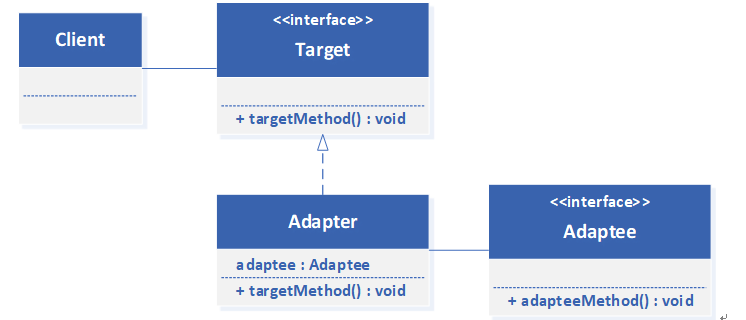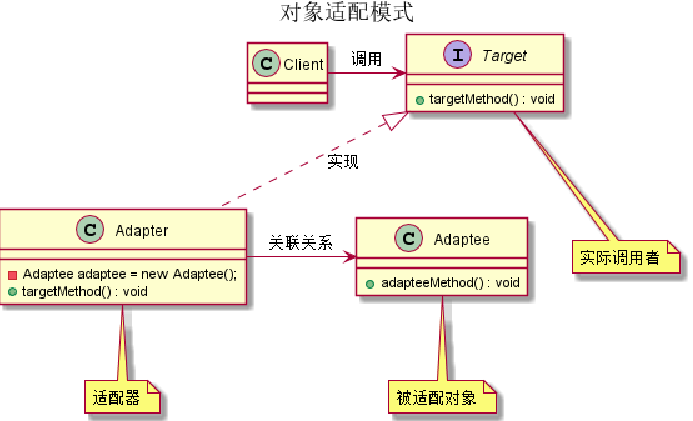1. 模式简介
适配器模式解决的问题:让原本因为接口不兼容而不能一起工作的类可以一起工作
适配器模式中有三种角色:
- 目标接口Target:用户期望的类,可以是接口,也可以是抽象类或具体类;
- 需要适配的类Adaptee:当前系统中有的类;
- 适配器Adapter:在现有接口和目标接口之间的“适配者”
适配器模式的优点:
通过适配器模式,用户在做相似的操作时可以调用同一个接口,其内部过程对于用户是透明的,这样做更简单、更直接、更解耦; 复用了现存的类,解决了现存类和复用环境要求不一致的问题; 将目标接口和现有接口解耦,通过引入一个适配器类,而无需修改原有的代码。
适配器模式的缺点:
使用适配器模式后,如果想要改变适配对象,就需要更换适配器,而更换适配器是一个非常复杂的过程。
适配器模式的适用场景: > 当系统需要使用现有的类,而现有的类不符合系统的接口 当期望的功能和系统中现有的某个类的功能相似,但是具有不同的接口 当系统已经实现某功能,但用户想通过另种接口方式访问,而不想修改原有接口 当使用的第三方组件的接口和系统中定义好的接口不同,不希望修改系统接口
2.案例代码
适配器分类_适配器模式_和对象适配器模式
2.1 类适配器UML

2.2 对象适配器模式UML

2.3 案例代码:
被适配对象
public class Adaptee {
public void adapteeMethod() {
System.out.println("这是我们已经实现的功能!");
}
}
对象适配器
public class Adapter implements Target {
private Adaptee adaptee = new Adaptee();
@Override
public void targetMethod() {
adaptee.adapteeMethod();
}
}
目标接口
public interface Target {
void targetMethod();
}
客户端调用
public class Client {
public static void main(String[] args) {
Target target = new Adapter();
target.targetMethod();
}
}
3.JAVA源码中的运用
有时候我们需要把集合变成线程安全的集合
List<Integer> list = Collections.synchronizedList(new ArrayList<>(10));
Map<String, String> map = Collections.synchronizedMap(new HashMap<>(8));
就拿Collections.synchronizedMap()来分析源码,其中
目标接口
Map<K,V> m
不多做说明,大家应该都知道这是字典的接口
被适配对象
new HashMap<>(8)
同步适配器 SynchronizedMap
private static class SynchronizedMap<K,V>
implements Map<K,V>, Serializable {
private static final long serialVersionUID = 1978198479659022715L;
private final Map<K,V> m; // Backing Map
final Object mutex; // Object on which to synchronize
SynchronizedMap(Map<K,V> m) {
this.m = Objects.requireNonNull(m);
mutex = this;
}
SynchronizedMap(Map<K,V> m, Object mutex) {
this.m = m;
this.mutex = mutex;
}
public int size() {
synchronized (mutex) {return m.size();}
}
public boolean isEmpty() {
synchronized (mutex) {return m.isEmpty();}
}
public boolean containsKey(Object key) {
synchronized (mutex) {return m.containsKey(key);}
}
public boolean containsValue(Object value) {
synchronized (mutex) {return m.containsValue(value);}
}
public V get(Object key) {
synchronized (mutex) {return m.get(key);}
}
public V put(K key, V value) {
synchronized (mutex) {return m.put(key, value);}
}
//////////////此处省略方法
}
很容易理解,在调用 synchronizedMap方法
public static <K,V> Map<K,V> synchronizedMap(Map<K,V> m) {
return new SynchronizedMap<>(m);
}
创建了一个同步适配器对象,其实就是注册了一把mutex锁
SynchronizedMap(Map<K,V> m) {
this.m = Objects.requireNonNull(m);
mutex = this;
}
然后在调用具体方法的时候会竟如同步块,比如put方法
public V put(K key, V value) {
synchronized (mutex) {return m.put(key, value);}
}
通过这种方式实现了map的线程安全同步,_Collections.synchronizedList方法_同理
4. 实际项目中运用
背景:有时候对于类的toString方法需要做修改,如果属性为空则赋值一些默认值,或者字符串为空的时候返回的是空字符串等,对此可以进行一些优化
抽象父类 AbstractDO
@Getter
@Setter
@EqualsAndHashCode(callSuper = false, of = {"id"})
public abstract class AbstractDO implements Serializable {
private static final long serialVersionUID = -1679770357930200297L;
@Id
@GeneratedValue(strategy = GenerationType.IDENTITY)
private Long id;
private Date createTime;
private Date updateTime;
}
具体实体类 SysResources
@Getter
@Setter
@Builder
@NoArgsConstructor
@AllArgsConstructor
public class SysResources extends AbstractDO {
private static final long serialVersionUID = 1936021577348624761L;
/**
* 资源名
*/
private String name;
/**
* 资源类型
*/
private String type;
/**
* 资源地址
*/
private String url;
/**
* 资源权限
*/
private String permission;
/**
* 父级资源
*/
private Long parentId;
/**
* 排序
*/
private Integer sort;
/**
* 是否外部链接
*/
private Boolean external;
private Boolean available;
/**
* 资源图标
*/
private String icon;
@Transient
private String checked;
@Transient
private SysResources parent;
@Transient
@Singular
private List<SysResources> nodes;
@Override
public String toString() {
//正常字符串拼接 省略
}
}
首先我的想法是不希望每次新建一个属性的时候去重新生成toString方法,当然你可以使用lombok的ToString注解去解决问题,下面说下我的思路:
目标对象 AdapteeTarget
public interface AdapteeTarget {
@Override
String toString();
/**
* StringBuilder拼接字符串
* @param capacity 初始化容量
*/
default String builderToString(int capacity) {
final StringBuilder builder = new StringBuilder(capacity);
try {
BeanInfo beanInfo = Introspector.getBeanInfo(this.getClass(), Object.class);
PropertyDescriptor[] list = beanInfo.getPropertyDescriptors();
builder.append(beanInfo.getBeanDescriptor().getName()).append("{");
for (int i = 0; i < list.length; i++) {
PropertyDescriptor descriptor = list[i];
if (i > 0) {
builder.append(", ");
}
builder.append(descriptor.getName()).append("=").append(descriptor.getReadMethod().invoke(this));
}
builder.append("}");
} catch (IntrospectionException | ReflectiveOperationException e) {
e.printStackTrace();
}
return builder.toString();
}
}
上面接口使用了java8接口的新特性和java内省知识对于javabean对象的获取
首先基于类适配器思想,让 SysResources去实现AdapteeTarget这个接口,并重写toString方法。代码如下:
@Getter
@Setter
@Builder
@NoArgsConstructor
@AllArgsConstructor
public class SysResources extends AbstractDO implements AdapteeTarget{
private static final long serialVersionUID = 1936021577348624761L;
//关键代码。。。。。。。。。。。。
@Override
public String toString() {
return this.builderToString(1 << 10);
}
}
这样如果项目中有很多实体类的时候,只需实现AdapteeTarget接口,覆写toString方法使用默认的this.builderToString方法就可以很方便解决问题。当然你可以说虽然你为了使用stringbuilder去优化字符串拼接,但是同时使用了反射,性能上并不能多大提升。确实,这样的写法只是减少对象的创建,但是性能不是最好的。
但是,如果需要对toString方法有些定制化需求,也是一种选择。比如我们需要String类型的字段默认值为空字符串,那么我们可以创建如下适配器:
字符串空适配器 StringAdapter
public class StringAdapter<T> implements AdapteeTarget {
private T t;
private int capacity;
public StringAdapter(T t, int capacity) {
this.t = t;
this.capacity = capacity;
}
@Override
public String toString() {
return ToStringUtil.getObjectString(t, capacity);
}
}
ToStringUtil 工具类
public final class ToStringUtil {
/**
* 字符串属性默认为""
*/
public static String getObjectString(Object t, int capacity) {
final StringBuilder builder = new StringBuilder(capacity);
try {
BeanInfo beanInfo = Introspector.getBeanInfo(t.getClass(), Object.class);
PropertyDescriptor[] list = beanInfo.getPropertyDescriptors();
builder.append(beanInfo.getBeanDescriptor().getName()).append("{");
commonBuilder(t, builder, list);
builder.append("}");
} catch (IntrospectionException | ReflectiveOperationException e) {
e.printStackTrace();
}
return builder.toString();
}
public static String getObjectStringValue(Class t, int capacity) {
final StringBuilder builder = new StringBuilder(capacity);
try {
BeanInfo beanInfo = Introspector.getBeanInfo(t, Object.class);
Object obj = t.newInstance();
PropertyDescriptor[] list = beanInfo.getPropertyDescriptors();
builder.append(beanInfo.getBeanDescriptor().getName()).append("{");
commonBuilder(obj, builder, list);
builder.append("}");
} catch (IntrospectionException | ReflectiveOperationException e) {
e.printStackTrace();
}
return builder.toString();
}
/**
* 设置属性默认之短
*/
public static String getObjectStringNotEmpty(Object t, int capacity, Map<Class, Object> map) {
if (CollectionUtils.isEmpty(map)) {
return getObjectString(t, capacity);
}
final StringBuilder builder = new StringBuilder(capacity);
try {
BeanInfo beanInfo = Introspector.getBeanInfo(t.getClass(), Object.class);
PropertyDescriptor[] list = beanInfo.getPropertyDescriptors();
builder.append(beanInfo.getBeanDescriptor().getName()).append("{");
defaultBuilder(t, map, builder, list);
builder.append("}");
} catch (IntrospectionException | ReflectiveOperationException e) {
e.printStackTrace();
}
return builder.toString();
}
public static String getObjectDefaultValue(Class cls, int capacity, Map<Class, Object> map) {
final StringBuilder builder = new StringBuilder(capacity);
try {
Object obj = cls.newInstance();
BeanInfo beanInfo = Introspector.getBeanInfo(cls, Object.class);
PropertyDescriptor[] list = beanInfo.getPropertyDescriptors();
builder.append(beanInfo.getBeanDescriptor().getName()).append("{");
defaultBuilder(obj, map, builder, list);
builder.append("}");
} catch (IntrospectionException | ReflectiveOperationException e) {
e.printStackTrace();
}
return builder.toString();
}
private static void defaultBuilder(Object t, Map<Class, Object> map, StringBuilder builder,
PropertyDescriptor[] list) throws IllegalAccessException, InvocationTargetException {
for (int i = 0; i < list.length; i++) {
PropertyDescriptor descriptor = list[i];
if (i > 0) {
builder.append(", ");
}
builder.append(descriptor.getName()).append("=");
Object o = descriptor.getReadMethod().invoke(t);
Class type = descriptor.getPropertyType();
if (Objects.isNull(o) && map.containsKey(type)) {
builder.append(map.get(type));
} else {
builder.append(o);
}
}
}
private static void commonBuilder(Object t, StringBuilder builder, PropertyDescriptor[] list)
throws IllegalAccessException, InvocationTargetException {
for (int i = 0; i < list.length; i++) {
PropertyDescriptor descriptor = list[i];
if (i > 0) {
builder.append(", ");
}
builder.append(descriptor.getName()).append("=");
Object o = descriptor.getReadMethod().invoke(t);
if (descriptor.getPropertyType() == String.class && Objects.isNull(o)) {
builder.append("''");
} else {
builder.append(o);
}
}
}
}
我们按对象适配器的方式改造SysResources
public class SysResources extends AbstractDO {
@Override
public String toString() {
AdapteeTarget target = new StringAdapter<>(this, 1 << 7);
return target.toString();
}
public static void main(String[] args) {
System.out.println(new SysResources());
}
}
创建一个空对象,打印接口如下:
SysResources{available=null, checked='', createTime=null, external=null, icon='', id=null, name='', nodes=null, parent=null, parentId=null, permission='', sort=null, type='', updateTime=null, url=''}
String字段的默认值都变成了空字符串
当然我们也有其他需求,比如修改其他类型的默认值,那我们可以创建如下适配器:
默认值自定义适配器 DefaultValueAdapter
@AllArgsConstructor
public class DefaultValueAdapter<T> implements AdapteeTarget {
private T t;
private int capacity;
private Map<Class, Object> map;
@Override
public String toString() {
return ToStringUtil.getObjectStringNotEmpty(t, capacity, map);
}
}
然后在重写 SysResources的toString方法
@Override
public String toString() {
Map<Class, Object> map = new HashMap<>(5);
map.put(Boolean.class, false);
map.put(Long.class, -1L);
map.put(List.class, new ArrayList<>(1));
AdapteeTarget target = new DefaultValueAdapter<>(this, 1 << 10, map);
return target.toString();
}
new一个对象得到的结果如下:
SysResources{available=false, checked=null, createTime=null, external=false, icon=null, id=-1, name=null, nodes=[], parent=null, parentId=-1, permission=null, sort=null, type=null, updateTime=null, url=null}
Long类型的默认值为-1,Boolean对象默认值是 false
另外当我们还有其他需求,比如toString方法只打印部分字段那么又必须写新的类,当适配器数量到达一定程定,我们可以参考Collections工具类考虑使用简单工厂方法:
适配器 AdapterFactory
public final class AdapterFactory {
//默认值设定
public static String builderDefaultValueAdapter(Map<Class,Object> map, int capacity, Class cls) {
return new DefaultValueAdapter(cls, capacity, map).toString() ;
}
//空字符串设定
public static String builderStringValueAdapter(Class cls, int capacity) {
return new StringAdapter(cls, capacity).toString();
}
@AllArgsConstructor
private static class DefaultValueAdapter implements AdapteeTarget {
private Class t;
private int capacity;
private Map<Class, Object> map;
@Override
public String toString() {
return ToStringUtil.getObjectDefaultValue(t, capacity, map);
}
}
private static class StringAdapter implements AdapteeTarget {
private Class t;
private int capacity;
public StringAdapter(Class t, int capacity) {
this.t = t;
this.capacity = capacity;
}
@Override
public String toString() {
return ToStringUtil.getObjectStringValue(t, capacity);
}
}
}
那么需要改进toString方法,如下:
@Override
public String toString() {
// Map<Class, Object> map = new HashMap<>(5);
// map.put(Boolean.class, false);
// map.put(Long.class, -1L);
// map.put(List.class, new ArrayList<>(1));
// return AdapterFactory.builderDefaultValueAdapter(map, 1 << 10, SysResources.class);
return AdapterFactory.builderStringValueAdapter(SysResources.class, 1 << 10);
}
这样就可以通过简单工厂调用具体的适配器,这样写的好处就是可以减少创建多个类文件,防止类爆炸。当然如果对于重写equalsandhashcode方法也需要不同的算法的场景,则可以使用策略模式,然后再使用工厂方法去实现单工厂多个模式生产线
[评论][COMMENTS]